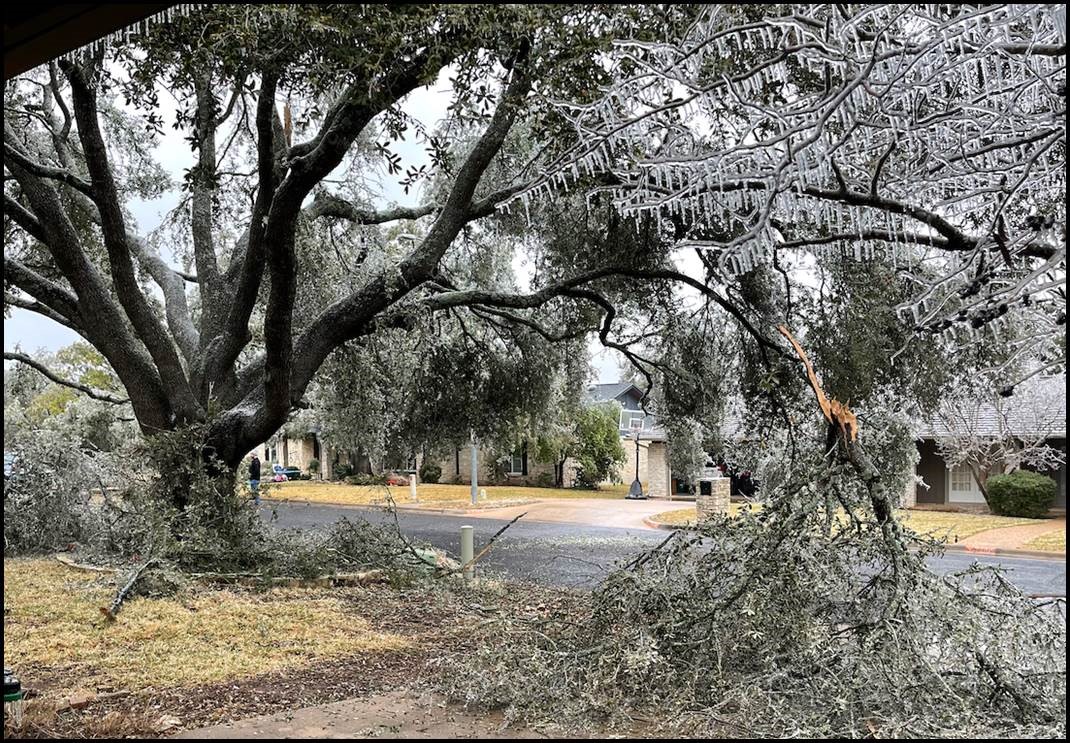Strengthening Community Resilience: Connecting Online and Offline Networks
By Jiayu Sun, Keri K. Stephens, Tara Tasuji, Kasey Faust & Sergio Castellanos
SUMMARY
An interdisciplinary team of researchers from the University of Texas at Austin (including TIPI researchers) explored how Texas communities responded during the 2021 winter storm. The study revealed that a unique communication approach called the Hybrid Hyperlocal Community of Practice (HCoP) significantly assisted residents in navigating the challenges during the cascading disaster that resulted in the loss of many infrastructure services, and lives.
The communicative process emerged among residents coping with critical infrastructure failures, such as massive power and water outages. Through qualitative interviews, the study reveals how these HCoPs facilitated community resilience by fostering mutual engagement, sharing repertoires, and negotiating joint enterprises during the cascading winter storm.
This study contributes to disaster resilience literature by demonstrating communities’ ability to adapt and function using innovative communication practices.
Problem
Cascading disasters are multiple disasters that happen one after another and are interconnected, posing unique challenges. They increase infrastructure vulnerabilities and disrupt community’s abilities to adapt to infrastructure challenges. The 2021 Texas winter storm showed these problems by causing widespread power and water outages during extreme weather. The ongoing COVID-19 pandemic made these issues worse.
The study underscores the urgent need to understand how communities develop resilience when faced with cascading failures. This is especially important regarding communication strategies. These communication strategies should blend online and offline platforms as they can help to maintain connectivity and support collective action in times of crisis. Addressing this research gap is crucial for enhancing disaster preparedness and response strategies tailored to complex, cascading disaster scenarios in the future.
Winter Storm Ice on Oak Trees

Key Takeaways
The study findings reveal that community resilience during cascading disasters is significantly enhanced through evolving communication practices and collaborative efforts. As disasters progress, residents adapt their communication methods, shifting from one-way official announcements to two-way interactions within neighborhood groups. Local online groups, such as Facebook and Buy Nothing groups, become crucial for sharing real-time and local updates, resources, and support. The winter storm unified neighborhood communities, leading residents to develop strategies together to cope with challenges like transportation, water, and power failures. Existing disaster-related knowledge and practices among residents are shared and utilized, improving overall community resilience.
The pandemic played a role in strengthening community bonds, which were then leveraged during the winter storm to provide mutual aid and support. Interestingly, official communications were found to be inadequate, prompting residents to rely on hyperlocal networks for accurate and timely information. This means that people within walking distance of one another could physically share resources. This study emphasizes the importance of being active in local online groups and building connections within the neighborhood to enhance preparedness and response
during complex disasters.
By staying engaged in these local networks, communities can better navigate the multifaceted challenges of cascading disasters, ensuring a more resilient and supportive environment for all members.
Methodology
Our research team conducted qualitative interviews with residents affected by the February 2021 Texas winter storm, which caused prolonged power outages, water shortages, travel disruptions, and significant property damage.
Thirty individuals from diverse communities impacted by the storm participated in our study, predominantly female with an average age of 36 years. The group encompassed a range of racial backgrounds. Following Institutional Review Board (IRB) approval, recruitment was conducted through local community websites, inviting those affected to share their storm experiences via email for Zoom interviews. Data collection occurred in two phases: 14 interviews in March and April 2022, and 16 more in March and April 2023, coinciding with a subsequent storm event similar in many ways. Interviews focused on exploring overall experiences, communication strategies, and coping mechanisms.
Two researchers reviewed transcripts from interviews and identified themes step by step, moving from general ideas to specific ones. This careful process created a clear story to meet the study’s goals. Participants received a $25 gift card for their help and all interviews were carefully transcribed for detailed analysis.
Acknowledgement:
This project was funded by a National Science Foundation (NSF) Grant: RAPID: Implications of Utilities Preparedness and Communication Strategies in Urban Populations’ Response under Extreme Weather Events, Award #2129801, and a Japan Science & Technology (JST) Grant: Resilience-based governance framework and practical models to build back better even before: Systems approach with the focus on cascading disasters.
Click below to read the full article:
https://www.tandfonline.com/doi/full/10.1080/00909882.2024.2341082
